Gmail How To Guide for Windows - Read and Answer your Gmail Offline
Every now and then, an improvement to an existing product comes along that just seems natural. Why, we wonder, wasn’t it available before? Such is the case with Google’s offline Gmail mode.
However, the reason it wasn’t available before is because the structure for it did not exist. This structure came to us in the form of Google Gears, the onboard component on our PC that powers Google Docs and Google Reader. If you use either in combined online-local mode, you already have Gears installed. If not, you’ll need it for offline Gmail, but this won’t obligate you to sign up for any other services.
How Well Does it Work?
Great!
In use, it looks and works just like Gmail online, except that it’s much faster because it’s loading from the hard drive rather than the Internet.
How much mail does it download? That’s more difficult to define. The company says that an algorithm determines how many and which messages will be downloaded. For my three-year-old Gmail account, it defaulted to all messages newer than five-years-old. Some other users have found that it downloads a maximum of 10,000 messages. The database came to about 67.2 MB on the hard drive.
How do I find out how much space the database is using on my hard drive? That depends on your version of Windows and web browser. For more information, please look here.
What about sending email? Just select “Compose Mail” and type it as usual. Where you’d normally select “Send,” Gmail will instead move it to your Outbox. Upon the next connection, the message will be sent. One difference, though, is that the use of attachments is not supported in offline Gmail.
Of course, you can also do the other normal things like reading messages, labeling them, or starring them in offline mode.
Setting Up for Offline Mail
To get started, go to your Gmail account and click the gear symbol in the top row. On the Settings page, click “Offline” on the top tab row. Click “Enable Offline Mail for this computer.” Click “Save changes” and follow the directions from there.
This will make an “Offline” link appear in Gmail on any computer you use. However, the offline mode only works when you have Gears installed on that computer. Here’s what the link looks like in your browser. (Look for the pale green highlight.)
When you click the link from your laptop for the first time, it will advise you that you need to install Google Gears. (Gears requires Firefox 1.5 or higher, Internet Explorer 6.0 or higher, or, of course, Google Chrome.) Click the “Install” button to get started.
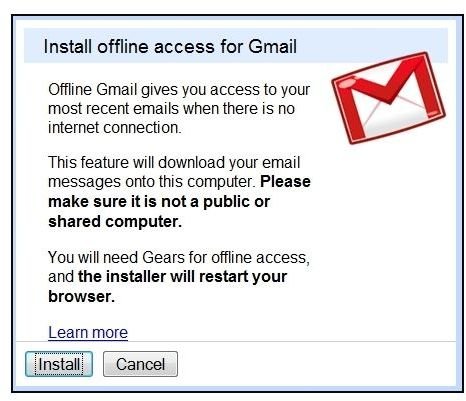
This will lead to this popup. Click “Install” again.
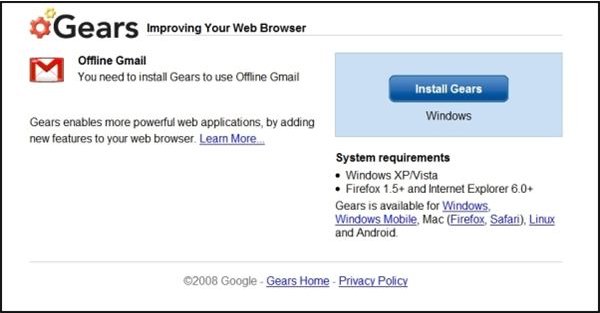
During the installation, a terms of service dialog is displayed that you have to agree to. Then Gears asks if you’d like to create a shortcut to Gmail on your desktop or in the Windows Start menu. The desktop shortcut, when clicked, starts your default web browser and goes to your Gmail main page. Then if online, it will connect, or, if offline, it will work in offline mode. An interesting additional feature is the “Flaky Connection” mode. It means exactly what it says. It allows Gmail to operate in a combined offline/online mode until the Internet connection is more stable.

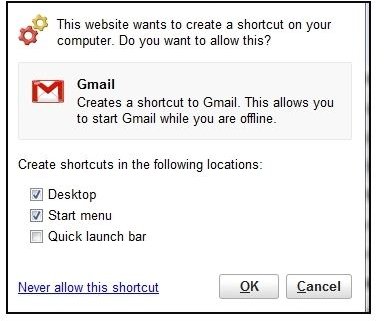
At the end of installation, Gears advises you that you need to restart your web browser. At restart of Firefox, the new Add-On for Google Gears is then included.
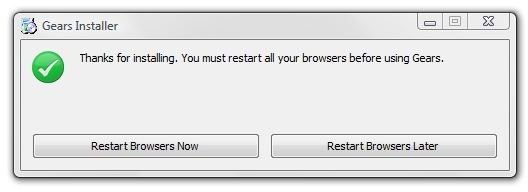
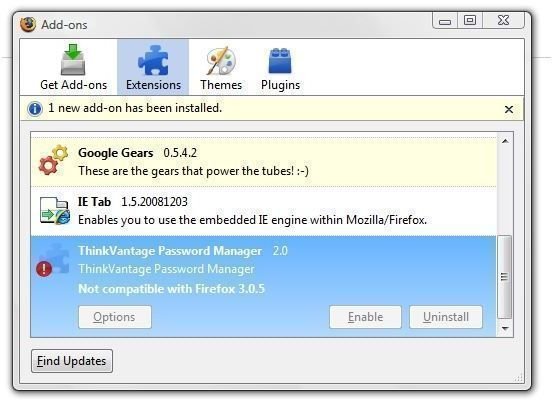
When you return to your browser window and click “Offline,” it will begin to synchronize your email with your laptop. When it says that it’s finished (which took about fifteen minutes for me), you’ll be able to disconnect the laptop from the Internet and work in offline mode.
Wrapping Up
You may be wondering how to delete the local mail that was downloaded. To do so in one fell swoop, go to Gmail → Settings → Offline and click “Disable.” According to Google, “This will disable offline access for your computer and delete the mail that you’ve previously downloaded. If you decide to enable offline access sometime in the future, you’ll download messages you’ve received since you last synced but won’t have to start from scratch.” They go on to point out that when you enable offline mail on your laptop, it’s not automatically enabled on all the computers you use, even though the Offline selection shows whenever you connect to your account.
Are there times when you would not want to enable offline Gmail? Sure! You’d never want to use it from a public computer. If you use it on your company’s laptop, you’ll need to remember to disable offline Gmail to delete the database before turning the laptop in.
When I first read about offline Gmail, I instantly thought that Gmail had taken a big, obvious step. MS Office Outlook and other email programs have long supported an offline mode. A lot of mail gets written and answered this way on airplanes and in taxis. Now we get to do it with our Gmail, too.
And that’s all good. Thanks, Google, for adding to the capabilities of web-based email!
